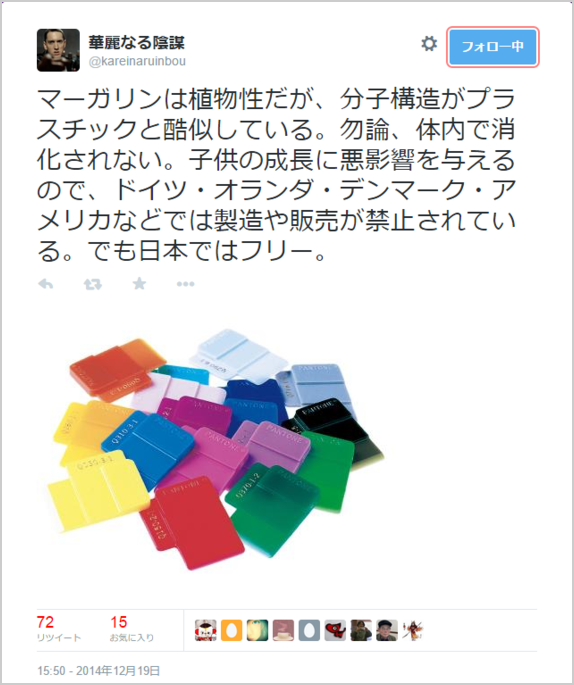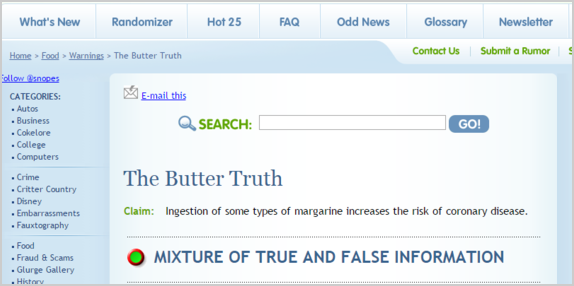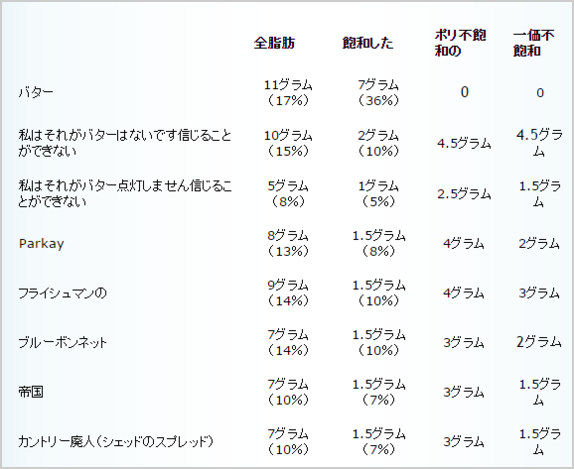The Butter Truth
- Component of chemical salt 子供の脳を破壊してしまう危険な食べ物
- 歴史の捏造
華麗なる陰謀・トランス脂肪酸

***
バターの真実

請求:マーガリン、いくつかのタイプの摂取は冠動脈疾患のリスクを増大させる。
真と偽情報の混合物 / MIXTURE OF TRUE AND FALSE INFORMATION
例:[電子メール、1999を介して収集]
Examples: [Collected via e-mail, 1999]
バターとマーガリンの違いは?
The difference between butter and margarine?
両方のカロリーと同じ量を有し、バター5グラムと比較して8グラムの飽和脂肪がわずかに高い。食べるマーガリンは、最近のハーバード·メディカルの調査によるとバターの同じ量を食べて上の53%の女性では心臓病を増やすことができます。
Both have the same amount of calories, butter is slightly higher in saturated fats at 8 grams compared to 5 grams. Eating margarine can increase heart disease in women by 53% over eating the same amount of butter according to a recent Harvard Medical Study.
他の食品にバターが増加の他の多くの栄養素の吸収を食べる、バターはマーガリンは、彼らが追加されるだけであるため、いくつかを持って多くの栄養の利点を持っています!バターはマーガリンよりもはるかに良い味、それは他の食品の風味を高めることができる。バターはマーガリンが100未満の年前から出回っている何世紀にも出回っている。
Eating butter increases the absorption of many other nutrients in other foods, butter has many nutritional benefits where margarine has a few only because they are added! Butter tastes much better than margarine and it can enhance the flavors of other foods. Butter has been around for centuries where margarine has been around for less than 100 years.
今トランス脂肪酸で非常に高いマーガリン、のために冠状動脈性心臓病のトリプルリスク、上げ総コレステロールおよびLDL(これは悪いコレステロールである)、HDLコレステロールを低下させ、これは良いものであり、最大5倍にすることにより癌のリスクを増大させる、母乳の品質を低下させる免疫応答を低下させ、インスリン応答を低下させる。
Now for Margarine, very high in trans fatty acids triple risk of Coronary Heart Disease, Increases total and LDL ( This is the bad Cholesterol), Lowers HDL cholesterol and this is the good one, Increases the risk of cancers by up to five fold, lowers quality of breast milk, decreases immune response, and decreases insulin response.
そして、ここで最も不穏な事実である......
And here is the most disturbing fact......
マーガリンがプラスチックであることから、一分子に過ぎない.....(この事実だけでは、これが水素で食品の分子構造を変え追加されたことを意味私が水素化されている生活や何かのためにマーガリンを避けているのに十分だった。)
Margarine is but one molecule from being PLASTIC..... (This fact alone was enough to have me avoiding margarine for life and anything else that is hydrogenated, this means hydrogen is added changing the molecular structure of the food.)
あなたは物事のカップルをメモします数日以内に、マーガリンの浴槽を購入し、あなたのガレージや日陰エリアでそれを残して、自分のためにこれを試すことができ、何ハエではなく、さらにそれらの厄介なショウジョウバエは(、その近くに行くんそれはなぜ...それは栄養価を持っていないので、何もしても、これらの小さなとても小さな微生物が成長するための家を見つけることができません、その上に成長しません...違った香りが、それが腐敗していない)何かを教えなければならない?
You can try this for yourself, purchase a tub of margarine and leave it in your garage or shaded area, within a couple of days you will note a couple of things, no flies, not even those pesky fruit flies will go near it, (that should tell you something) it does not rot, smell differently... Because it has no nutritional value, nothing will grow on it, even those teeny weeny microorganisms will not find a home to grow... Why?
それはほぼプラスチックですので。あなたはあなたのタッパーウェアを溶融し、あなたのトーストにそれを広げますか?
Because it is nearly plastic. Would you melt your Tupperware and spread that on your toast?
起源:上記の引用符で囲まれたコンパイルは"、マーガリン対バター」は、多くの場合、タイトルの下に、2003年6月にインターネット上で循環し始め、驚くほど十分にそれに真実の公平なビットは、少なくとも一度、ありました。 2003年に医学界における最新の知見によれば、マーガリン、スプレッドに含まれる脂肪の種類に応じてバターを、心臓病のリスクを高める可能性がある。
Origins: The above-quoted compilation began circulating on the Internet in June 2003, often under the title "Butter vs. Margarine," and surprisingly enough there was a fair bit of truth to it, at least at the time. According to the latest findings in the medical world in 2003, margarine could increase the risk of heart disease, depending Butter upon the type of fat contained in the spread.
以前は、冠動脈疾患の発症における食餌悪役は脂肪を飽和すると推定されたが、新たな証拠は(もトランス脂肪酸として知られている)トランス脂肪で指を指しています。バター、食事の欠点の独自のセットがありますが、それはトランス脂肪が含まれていません。
Previously, the dietary villain in the development of coronary disease was presumed to be saturated fat, but new evidence points the finger at trans fat (also known as trans fatty acids). Although butter has its own set of dietary shortcomings, it does not contain trans fat.
1994年、ハーバード大学の研究者は、部分的にトランス脂肪が高い硬化油を、食べた人々は、物質のはるかに少ない消費し者たちのような心臓発作のほぼ二倍のリスクを持っていたと報告している。ハーバード大学公衆衛生学部の研究者が行った看護師の健康調査などの他の場所で、米国とのいくつかの大規模な研究は、また以前の死とトランス脂肪の高い食品の消費量との間に強い関連性を示唆している。
In 1994, Harvard University researchers reported that people who ate partially hydrogenated oils, which are high in trans fats, had nearly twice the risk of heart attacks as those who consumed much less of the substance. Several large studies in the United States and elsewhere, including the Nurses' Health Study conducted by researchers at the Harvard School of Public Health, have also suggested a strong link between earlier death and consumption of foods high in trans fat.
トランス脂肪は、肉および乳製品を含むいくつかの食品中に少量で天然に発生するが、植物油は、化学的にそれらをより長い貯蔵寿命を与えるために変更されたときにアメリカの食事の中で最もトランス脂肪が形成されている。クッキー、ポテトチップス、焼いた製品、などが特にトランス脂肪がロードされる。
Trans fats occur naturally in small amounts in some foods, including meat and dairy products, but most trans fats in the American diet are formed when vegetable oils are chemically changed to give them a longer shelf life. Cookies, potato chips, baked products, and the like are particularly loaded with trans fats.
すべてがお勧め食品医薬品局(FDA)、ナショナル·アカデミー、国立心肺血液研究所、および米国心臓協会
he Food and Drug Administration, the National Academy, the National Heart, Lung, and Blood Institute, and the American Heart Association all recommend
可能な限り消費者はトランス脂肪の摂取を制限する。また、連邦政府は2006年までに、すべての食品のラベルは、製品が含まれているどのくらいのトランス脂肪開示することを要求する規則を可決した。
consumers limit their intake of trans fat wherever possible. Moreover, the federal government passed regulations requiring that by 2006 all food labels disclose how much trans fat a product contains.
彼らはその後、処方したとして2003年には、マーガリンの様々なブランドのために、以下の比較表をコンパイルした我々。グラムで与えられた数値は、脂肪のそれぞれの特定の種類の多くのグラムのは、そのブランドの大さじあたりいくつあるかを参照してください。 (バターやマーガリンのテーブルスプーンは14グラムが含まれています。)数字のパーセンテージは、その物質の推奨される日当上でそのスプレッドの1杯の影響を表すように与えられた。サンプリングされたマーガリンは「浴槽」多様であった。 (「スティック」で同じマーガリンは、フォームが一貫して高い数字を持っていた。)
Back in 2003 we compiled the following comparison chart for various brands of margarine as they were then formulated. Numbers given in grams refer to how many grams of each particular type of fat there are per tablespoon of that brand. (A tablespoon of butter or margarine contains 14 grams.) Numbers given as percentages represent the impact of one tablespoon of that spread on the recommended daily allowance of that substance. Margarines sampled were of the "tub" variety. (The same margarines in "stick" form had consistently higher numbers.)

バターは動物性製品であるため、大さじあたり30 mgまたはUSDA推奨される日当の10%にのぼる、コレステロールが含まれています。それらは非動物製品であるため、マーガリンは、ない。上記のチャートは、この情報が常にバック、製品ラベルに含まれていなかったので、(彼らはどのくらい、行った場合、または)マーガリンはトランス脂肪が含まれて何かについて述べています。
Because butter is an animal product, it contains cholesterol, amounting to 30 mg per tablespoon or 10% of the USDA recommended daily allowance. Margarines, because they are non-animal products, do not. The preceding chart says nothing about which margarines contained trans fats (or, if they did, how much) because this information was not always included on product labels back then.
警告とここ数年でトランス脂肪に関する条例の発行以来、多くのマーガリンの生産者は、自社製品を再定式化している。私は、(多価不飽和それはバターが、今の例、(2006年の)のために4グラムにそれぞれ4.5グラムから減少している「NOトランス脂肪」、およびサービングあたりの多価不飽和および一価不飽和脂肪の量を宣言、そのラベルに予告を負いいないと信じてすることはできません)と2G(モノ不飽和)食当たり。
Since the issuance of warnings and regulations about trans fats in the last few years, many margarine producers have reformulated their products. I Can't Believe It's Not Butter, for example, now (in 2006) bears a notice on its label proclaiming "NO TRANS FAT," and the amount of polyunsaturated and monounsaturated fat per serving has dropped from 4.5g each to 4g (polyunsaturated) and 2g (monounsaturated) per serving.
電子メールで与えられた大量の情報が有効であるが、知性の1ビットが誇大以上のものはより強く彼のポイントを作るための努力に著者によってで投げていないです。一部の食料品はクレームが、明らかに食べられない(あるいは毒性)物質であることから「離れて単一分子は、「加工食品の多様に適用されている:
Although a great deal of the information given in the e-mail is valid, one bit of intelligence is nothing more than hyperbole tossed in by the author in an effort to make his point more strongly. The claim that some comestible is but a "single molecule away" from being a decidedly inedible (or even toxic) substance has been applied to a variety of processed foods:
[電子メールを介して収集、2005年11月]
私はクールホイップと発泡スチロールの差が1分子が...これが本当であること言われた???
[Collected via e-mail, November 2005]
I was told that the difference between Cool Whip and Styrofoam is one molecule... is this true???
***
[電子メールを介して収集、2006年12月]
velveetaプロセスチーズフードはプラスチックから本当に1分子違うのですか?
[Collected via e-mail, December 2006]
Is velveeta processed cheese food really one molecule different from plastic?
***
[電子メールを介して収集、2007年3月]
パムスプレーは、1分子がプラスチックから離れているため、危険であることを聞いた?
[Collected via e-mail, March 2007]
heard that Pam spray is 1 molecule away from plastic and is therefore dangerous??
***
[電子メールを経由して2008年1月に集め]
私は私の夫を聞き飽きがCheezウィズはゴミ袋からわずか2成分は異なることを言うです。あなたは私がまっすぐに彼を設定して助けてくださいことはできますか?
[Collected via e-mail, January 2008]
I am tired of hearing my husband say that Cheez Whiz is only 2 ingredients different from garbage bags. Can you please help me set him straight?
文のこれらのタイプは、(彼らは真であったとしても)基本的には無意味である。多くの異なる物質が類似の化学的特性を共有するが、それでも、分子構造のわずかな変動は、これらの物質の性質の違いの世界を作ることができます。
These types of statements (even if they were true) are essentially meaningless. Many disparate substances share similar chemical properties, but even the slightest variation in molecular structure can make a world of difference in the qualities of those substances.
2005年に循環し、「バターマーガリン対「郵送の一部は、この序文は、それらの上にタック持っていた:
Some of the "Butter vs. margarine" mailings circulated in 2005 had this preface tacked onto them:
マーガリンはもともと七面鳥を太らせるために作製した。それは七面鳥を殺したときに彼らが戻って彼らのお金を得るために、この製品をどのように処理するかを把握するために一緒に頭を置くように、研究にすべてのお金を入れていた人々は、投資回収を望んでいた。彼らは黄色の着色を追加し、バターの代わりに使用する人々にそれを販売しますので、食べ物のない魅力を持つ白い物質だった。いかがですか?彼らはいくつかの巧妙な新調味料で出ている。
Margarine was originally manufactured to fatten turkeys. When it killed the turkeys, the people who had put all the money into the research wanted a payback so they put their heads together to figure out what to do with this product to get their money back. It was a white substance with no food appeal so they added the yellow coloring and sold it to people to use in place of butter. How do you like it? They have come out with some clever new flavorings.
クレームに反して、マーガリンは七面鳥fattenerとして発明されていませんでした。それは、バターのための実行可能な低コストの代替品を生産で成功する可能性が誰に賞品のナポレオン3世の募集に応じて、フランスのイポリットMègeMouriesのことで1869年に策定された。彼はマーガリンを吹き替えMègeMouriesの「調合は、軟化し牛脂に塩辛い水、牛乳、およびマルガリン酸を添加することによって達成された。世紀の変わり目では、オリジナルレシピで牛肉の脂肪は植物油に置き換えられていた。
Contrary to the claim, margarine was not invented as a turkey fattener. It was formulated in 1869 by Hippolyte Mège Mouriès of France in response to Napoleon III's offering of a prize to whoever could succeed at producing a viable low-cost substitute for butter. Mège Mouriès' concoction, which he dubbed oleomargarine, was achieved by adding salty water, milk, and margaric acid to softened beef fat. By the turn of the century, the beef fat in the original recipe had been replaced by vegetable oils.
1886年、ニューヨークとニュージャージー州が黄色のマーガリンの製造及び販売を禁止し、そして1902により、32の州は、スプレッドの着色に対してそのような禁止を制定していた。 (人々は白いマーガリンに黄色の食品着色料を混合することにより、これを回避ました。)1950年にトルーマン大統領がされるようになってきた黄色のマーガリンの広範な生産につながったマーガリンのみ着色されていない状態では販売のために提供されるという要件を、廃止規範。
In 1886, New York and New Jersey prohibited the manufacture and sale of yellow-colored margarine, and by 1902, 32 US states had enacted such prohibitions against the coloration of the spread. (Folks got around this by mixing yellow food coloring into the white margarine.) In 1950 President Truman repealed the requirement that margarine be offered for sale only in uncolored state, which led to the widespread production of the yellow margarine that has come to be the norm.
バーバラ「ゴールドスタンダード」Mikkelson
Barbara "gold standard" Mikkelson
最終更新日:2012年4月3日
Last updated: 3 April 2012
出典:Sources
Barbozaの。 「ウエストラインの拡大に警告。」
ニューヨーク·タイムズ紙。 2003年7月10日(P。C1)。
Barboza. "A Warning in Expanding Waistlines."
The New York Times. 10 July 2003 (p. C1).
Lesie、ミケーレ。 「ファット·サイエンスのセンスアウト作る。」
[クリーブランド]プレーンディーラー。 1998年9月14日(P。F1)。
Lesie, Michele. "Making Sense Out of Fat Science."
[Cleveland] Plain Dealer. 14 September 1998 (p. F1).
Sagon、キャンディ。 「 - と2003年にあなたの食事療法を変更します他のアイデアバターが帰ってきた」
Sagon, Candy. "Butter Is Back — and Other Ideas That Will Change Your Diet in 2003."
ワシントンポスト。 2003年1月1日(P。F1)。
The Washington Post. 1 January 2003 (p. F1).
スクワイアーズ、サリー。 「食品のラベルには、トランス脂肪をリストする必要があります。」
Squires, Sally. "Food Labels Must List Trans Fats."
ワシントンポスト。 2003年7月10日(P。A3)。
The Washington Post. 10 July 2003 (p. A3).